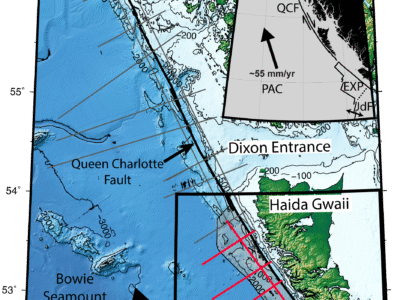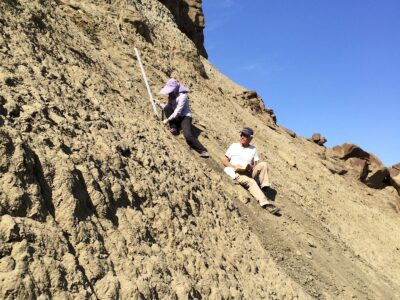
As a researcher and the Higgins Professor of Earth and environmental sciences, Steve Goldstein has had the opportunity to travel the globe in service of science. But his favorite institution of higher learning is on home turf: New York’s Lamont-Doherty Earth Observatory. Why? All of the tremendous people who work there and their eagerness to collaborate, says Goldstein. Such collaborations at Lamont have led to (literal) seismic discoveries, such as plate tectonics and the first map of the Atlantic Ocean floor.
Another aspect of Lamont that Goldstein loves: the opportunity to use science to reveal and solve many of the mysteries about the workings of our planet. “I’m fascinated by a lot of different aspects of the Earth,” he says, “and I’m lucky enough to have fallen into a field that allows for such flexibility.” Goldstein spoke with State of the Planet about his love of mountains, why Earth science will be instrumental in combatting climate change, and how some of the coolest scientific discoveries can be found right beneath our feet.
How long have you been at Lamont-Doherty Earth Observatory and what brought you there?
I first heard about Lamont as an undergraduate at Columbia. I knew it was an exciting place for research, but I still went off to graduate school elsewhere. I came back to Columbia for my Ph.D. After graduating, I was very fortunate to have a position at a Max Planck Institute in Germany, one of the best places in the world to do science. But when I got an opportunity to come back to Lamont in 1996, I took it.
You’re a leader in the field of isotope geochemistry. Tell us a bit about your research.
I mainly use natural radioactive decay and its products to trace Earth processes and determine the age of historical events. Radioactive substances decay at a constant rate, so they give us a way to track time on a geologic scale. This type of research is amazingly versatile and offers opportunities to work across the geosciences, and to address processes playing out in the Earth’s core, its surface and across the cosmos. That has allowed me to study questions ranging from the early history of the Earth, to mantle and continental evolution, to how volcanoes work, to ocean circulation and recent climate change.
What inspired your career in Earth sciences?
Ever since I was a child I was fascinated by mountains. I grew up in Maryland, but my parents were New Yorkers, and my grandparents took me to the Catskills in the summer. Being in the mountains was the high point—excuse the pun—of my year. I got the idea into my head that by studying geology I could spend my working time outside and in the mountains. It hasn’t quite turned out like that, but I’ve done fieldwork on almost every continent, and in every ocean.
The most rewarding aspect of working in the Earth sciences has been the opportunity to interact with people from different cultures. Earth scientists go where certain rocks are, and it gives us the opportunity to interact with people living outside of the tourist economy. I’ve had wonderful experiences as the guest of very gracious people in every hemisphere. These interactions have been by far the best experiences of my career, and it gives me some hope for humanity.
You’ve also been recognized for excellence in teaching at Columbia. In your opinion, what qualities do great teachers possess and what keeps you returning to the classroom year after year?
I’m lucky that the courses I teach are simply great subjects to teach. My biggest and most general course is team-taught with Sidney Hemming. Our philosophy is to give students an appreciation for the natural world by teaching them how to interpret their surroundings. Geology is everywhere, even in Manhattan. In fact, one can see the entire geologic history of the NYC region, beginning with the continental “basement,” which formed around 1 billion years ago, to the continental collisions that formed the Appalachian mountain belt between 500 and 300 million years ago, culminating in the formation of the supercontinent Pangea, to its breakup around 200 million years ago, to the last great continental glaciation 20,000 or so years ago.
NYC’s architecture also offers insights. We have a lab exercise that sends students to identify the rocks used to build and decorate some local buildings. Being able to interpret and appreciate building stones adds an extra layer of enjoyment to walking around the city. Sidney and I also teach a class where we take junior and senior majors and concentrators alternately to Italy and Barbados during spring break.
What has kept Lamont at the forefront of research and innovation in Earth sciences?
There are few research institutions that cover the breadth of the geosciences like Lamont. It’s able to do so because of its size: 65 research professors and research scientists, around 30 tenure-track DEES faculty members, 40 postdocs and 90 graduate students, and affiliated scientists all over the world. That allows for a lot of disciplinary coverage. It’s an entrepreneurial group that works in parallel and together on the beautiful Lamont campus. There are science talks nearly every day, through which people find connections that lead to important new projects. It’s the combination of breadth, the entrepreneurial spirit of the scientists and their eagerness to collaborate that’s been key to its success.
What is your vision as interim director of Lamont?
Lamont has been at the forefront of Earth science discovery for nearly 75 years. In Lamont’s early history, there was a focus on mapping and sampling the ocean floor, and the discoveries led to plate tectonics, which explains how the Earth works. Later Lamont was on the forefront of discovering how the climate system works.
In my opinion, the 21st century will be the century of the geosciences, as humanity will have to deal with critical challenges that stem from the natural world. An obvious one is the climate challenge, which anyone paying attention can see is reaching a critical stage. There is the green energy challenge, which requires both carbon sequestration and storage, and the extraction of strategic elements used to transform and store energy alternatives to fossil fuels. Water resources are a major problem in many parts of the world. And there are many other non-climate related natural challenges: geohazards like the devastating earthquakes in Turkey and Syria last year and Morocco and Afghanistan this year. Some current research at Lamont focuses on AI to observe seismicity with the aim of better predicting earthquakes.
We seem to be at a tipping point when it comes to the health of our planet. How is Lamont engaging in research and science to make a difference?
Lamont has made a difference in our understanding of how the Earth works, and how the climate system works, including the concept of tipping points. The creation of the Columbia Climate School offers great new opportunities to address humanity’s challenges stemming from the natural world. It offers a hub for experts who focus on science, and on mitigation, solutions and societal implications, to get together and coordinate their efforts. Lamont is the scientific center of this effort, and it will play the critical role of training the next generation who will be at the forefront of addressing these challenges.
This interview has been edited for length and clarity.



